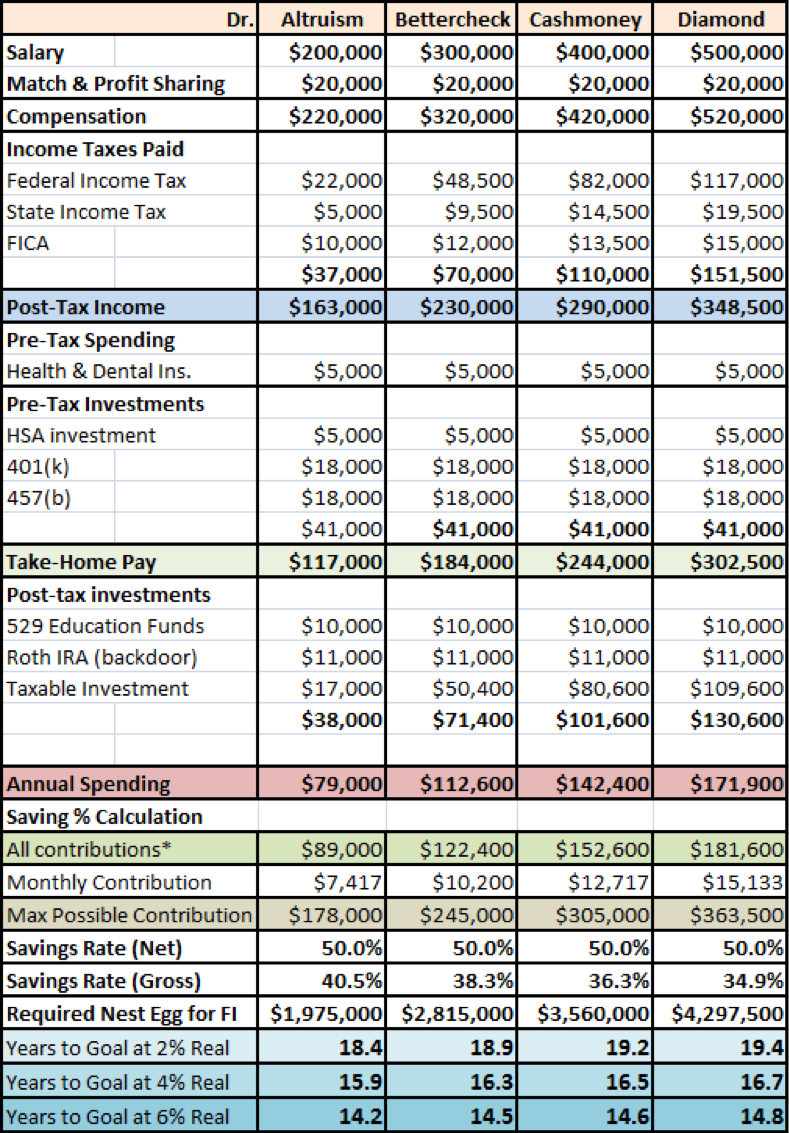Article
What Happens When You Live on Half Your Household Income
Author(s):
Living on half of your take-home pay, or to put it another way, saving and investing as much as you spend, should lead to financial independence in roughly 15 to 20 years.
It’s not a suggestion or a recommendation. It’s a challenge. By finding a way to meet this challenge, a reward is in sight.
How so? Living on half of your take-home pay, or to put it another way, saving and investing as much as you spend, should lead to financial independence (FI) in roughly 15 to 20 years.
Work becomes optional.
Life can be lived on your own terms, and that’s a reward that makes certain sacrifices well worth it.
What kind of a sacrifice are we talking about? I’m so glad I asked! Altering the hypothetical physician’s budgets from a previous post on specialty choice, we can derive an annual spending budget for each of these four physicians with household incomes of $200,000, $300,000, $400,000, and $500,000 by giving them a 50 percent net savings rate. [Calculate your savings rate here]

With a 50 percent net savings rate, representing 35 percent to 40 percent gross savings rates, these physicians are indeed financially independent in 14 to 19 years with a realistic range of real (inflation-adjusted) returns from 2 percent to 6 percent.
On the lowest end of the spectrum, our physician families were spending $79,000 a year on a $200,000 salary, requiring just under $2 million to be financially independent, with 25 years of expenses saved after 14 to 18 years.
The biggest income producers were able to spend $171,900 every year and would have a coveted FI status of $4.3 million in approximately 15 to 19 years.
The seven to 12-month discrepancy can be explained by the fact the $10,000 529 contributions, which do not count toward retirement savings, become relatively smaller on a percentage basis as income increases, allowing slightly more spending as a percentage of take-home pay. I don’t want you to miss the forest for the trees, but I thought that was a point worth mentioning. I know my astute readers would call me out in the comments; it wouldn’t be the first time.
What other assumptions have I made? Besides the dumb one about my vesting schedule? In order to make tax and net worth calculations, we must start with assumptions.
Each of these physicians is married with two children, filing jointly. We start keeping track when they have a net worth of zero, which is very likely at least a couple years after residency for most. They live in a middle-of-the-road income tax state, and the stated income is total household income.
The Live On Half Challenge for Physicians
I frequently refer to the benefits of being FI, and all of them can be yours if you accept the challenge and earn a solid living for fewer than two decades.
All you have to do is live with a budget of 60 percent to 340 percent more than the average American household, which spends about $50,000 a year. With an extra $29,000 to $120,000 to spend every year, you should be able to manage. You got through residency without spending more than $79,000 a year, didn’t you? I certainly hope so!
Our family of four managed to live quite well over the last year on less than $79,000. If we had a mortgage, our budget might have looked more like that of Dr. B. That’s OK. My in-demand specialty, along with a little geographic arbitrage makes me a Dr. C in terms of earning power.
I’ve written about what it means to be a frugal physician, which is what you will need to be if you are a Dr. A with a household income of $200,000. To keep your budget in check, focus on the big stuff — home, cars, private schools, second homes, second wives.
If you’re a Dr. C or Dr. D, you’ve got $142,000 or $172,000 to spend each year. If you can’t figure out how to live on that measly sum, I’m afraid I can’t help you.

Pickpockets. Must be the problem.
What About My Debt?!?
I’ll do you a solid. I called it the “Live on Half” challenge, not the “Save Half” challenge for a reason. You can spend half your paychecks, and we won’t count debt payments as spending. As long as the other half of that check is being used to retire debts, it’s being put to good use.
Consequentially, it might take you a bit longer to hit your FI target compared to the four featured physicians, but their stories started with a zero net worth. If you’re in the red, you’ll need a little time to dig out. That’s fine; take as much time as you need. As long as you’re Living on Half.
Can you rise to the challenge? If so, tell me about it. If not, what’s holding you back?




